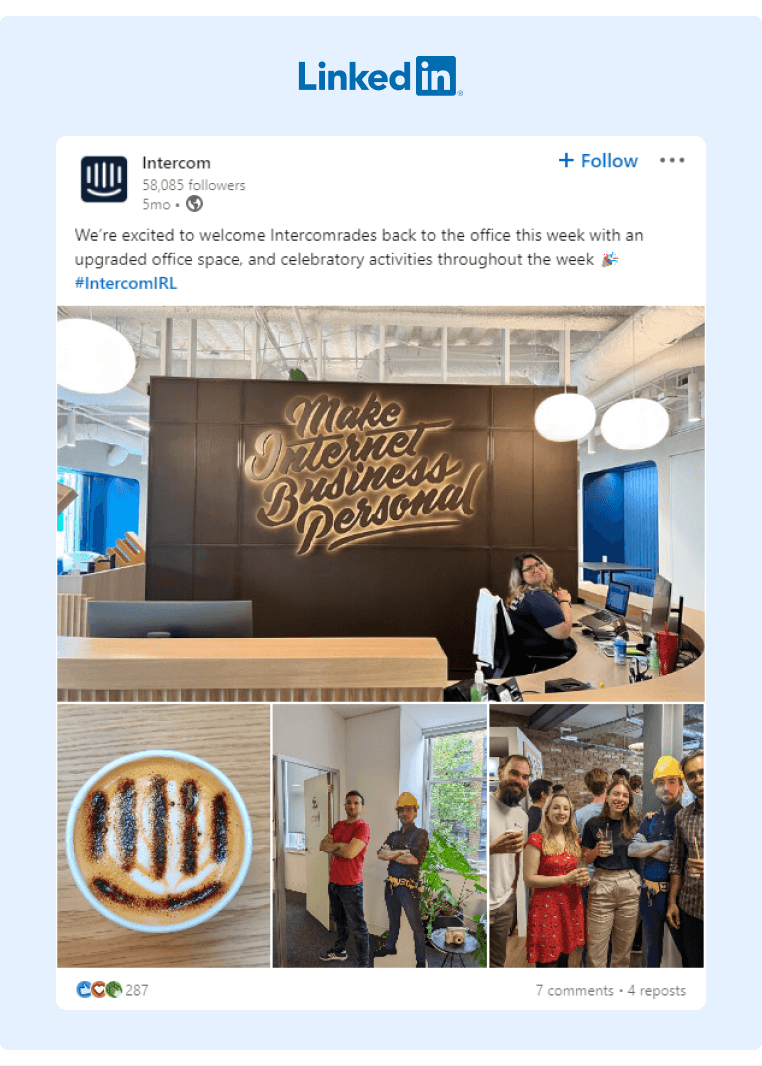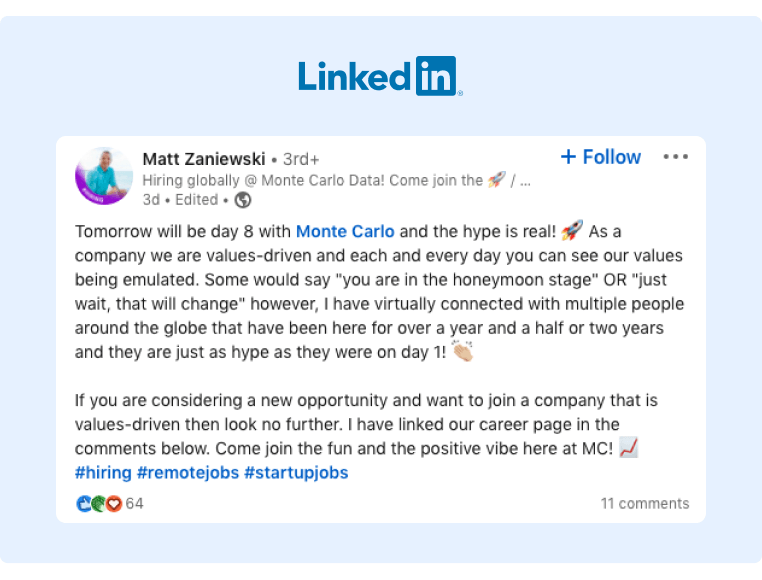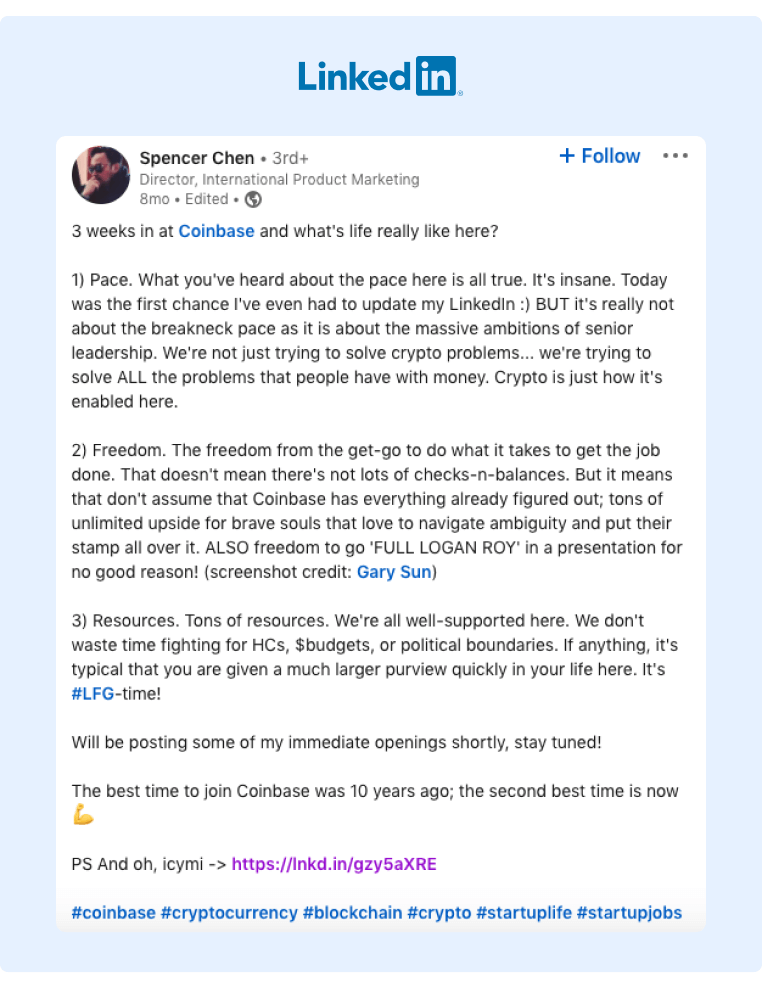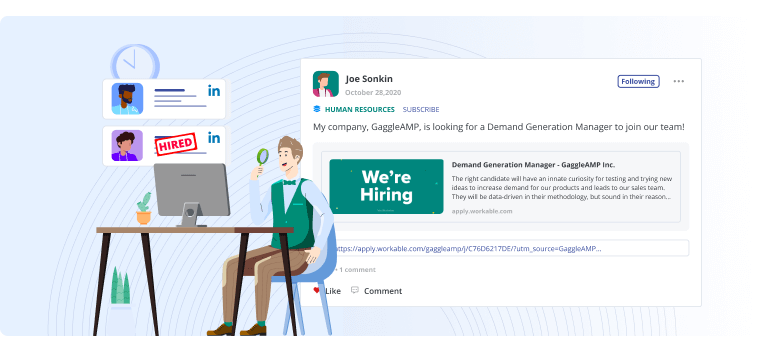Social Media Recruiting: Underrated Strategies and Examples for 2024
The common social media recruiting methods include things like:
- Create a clear job description that emphasizes the benefits of working with your brand
- Include relevant hashtags
- Share it across all of your social media channels
- Create a variety of content types (video, text, etc.)
All of these tips are sound advice.
The only problem is that most companies are already following these social hiring best practices and aren’t generating quality applicants.
Why?
Most people browsing social media are online because they want to connect with other people. They don’t want to be bombarded with branded job posts (especially if they already have a great job, which is usually the case with top performers).
However, social media is teeming with ideal candidates who might be interested in joining your company if they know it is truly an outstanding opportunity.
So how can you effectively leverage social media for recruiting?
We believe that the answer is to use social media as it was intended to be used – to facilitate personal interactions between friends online. Therefore, leverage your existing employees to tell their networks about your job opportunities.
So in this post, we’ll walk you through how you can create a social recruiting strategy that consistently attracts top-quality candidates across various social media platforms by leveraging your employees’ networks.
A Social Media Recruiting Strategy That Works
There are a few key reasons why leveraging employees' networks is much more effective than posting a job position on the company page:
-
You can multiply total reach – your employees' combined networks are likely much larger than the company page's total followers. People also tend to engage more with content published by other people than branded content.
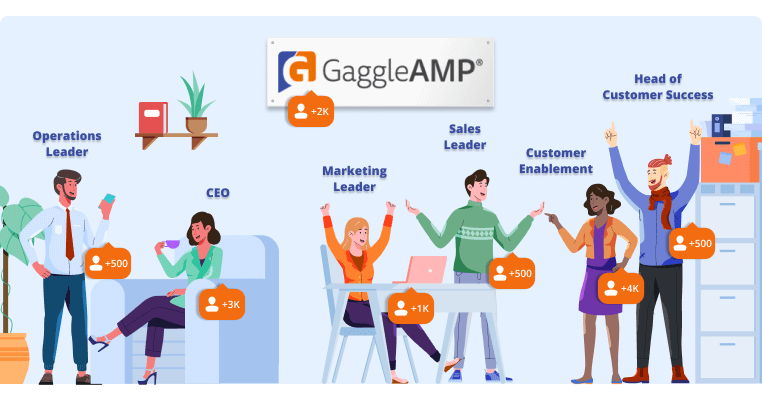
-
Passive candidates tend to give more consideration to open positions recommended by friends than from brands. This is because candidates know that their friends have a vested interest in their well-being as opposed to a brand that is only incentivized to find a good job applicant.
-
Assuming you've built a team of A players, your employees' connections tend to generate higher quality candidates than average job seekers scrolling through company pages looking for open positions.
-
The company's page will gain more followers and organically attract great talent if you consistently leverage employee advocacy to promote the brand's mission and values (rather than just job posts). Top talent is also more likely to want to work with your team if they see that the other employees are thought leaders in the space.
So below, we'll walk you through exactly how you can create an effective employee advocacy strategy that organically attracts qualified candidates.
1. Upgrade The Company’s Social Media Profile
Optimizing your company's social media profiles is table stakes.
While having a well-optimized company page probably won't automatically drive a large volume of applications, it's still necessary to follow these social media marketing best practices so that the right candidates have an excellent first impression of your brand once your employees introduce them to it.
To help you make sure your company profile is optimized, go through this checklist:
- Are the company's logo and banner images high quality/resolution and similar colors?
- Optimize your CTA ("Visit Website," "Contact Us," "Register," etc.)
- Create a captivating tagline
- Include relevant keywords as it can help you earn some SEO presence
- Fill out all information like headquarters location, industry, company size, etc.
LinkedIn also released a host of new features you can add to your company's profile, like Life, Products, and Insights, so fill out those tabs as well.
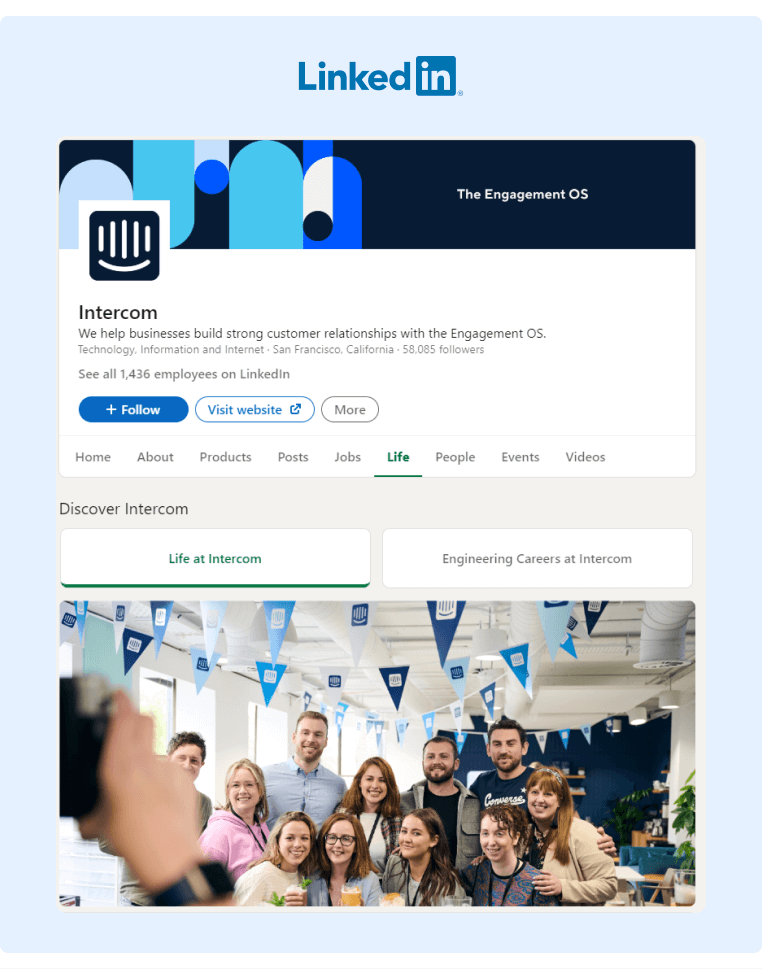
Another critical tab that it offers is the "Jobs" tab. Here's a complete guide to creating a LinkedIn job post, though to give you some quick inspiration, here are a few great examples of well-designed job descriptions:
- Job description for Technical Support Manager
- Job description for an AT&T Specialist
- Job description for 401(K) Plan Specialist
Once you've completed this step, job candidates will be able to find your listing when they actively search for opportunities:
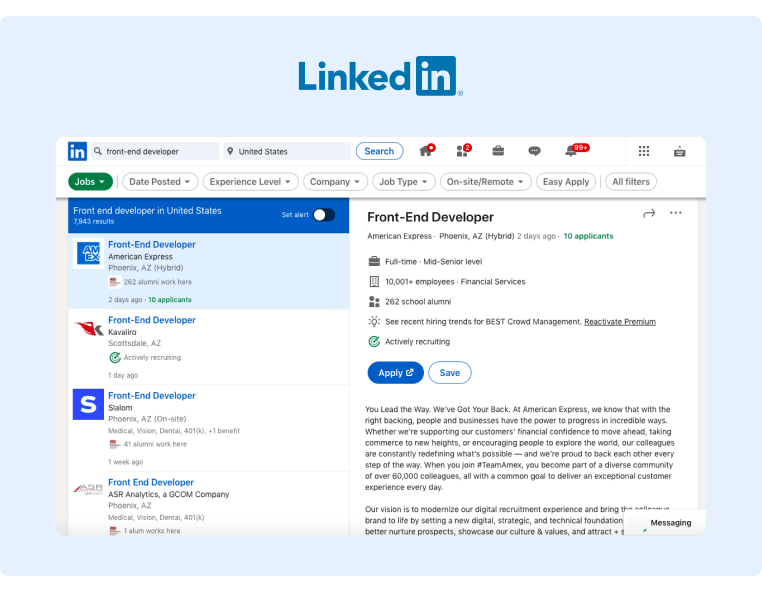
While the tips above show how to optimize a LinkedIn company page, it's worth noting that LinkedIn isn’t the only social platform great candidates use. For example, Twitter, Instagram, and even TikTok are also excellent social media sites for recruiting and have less competition.
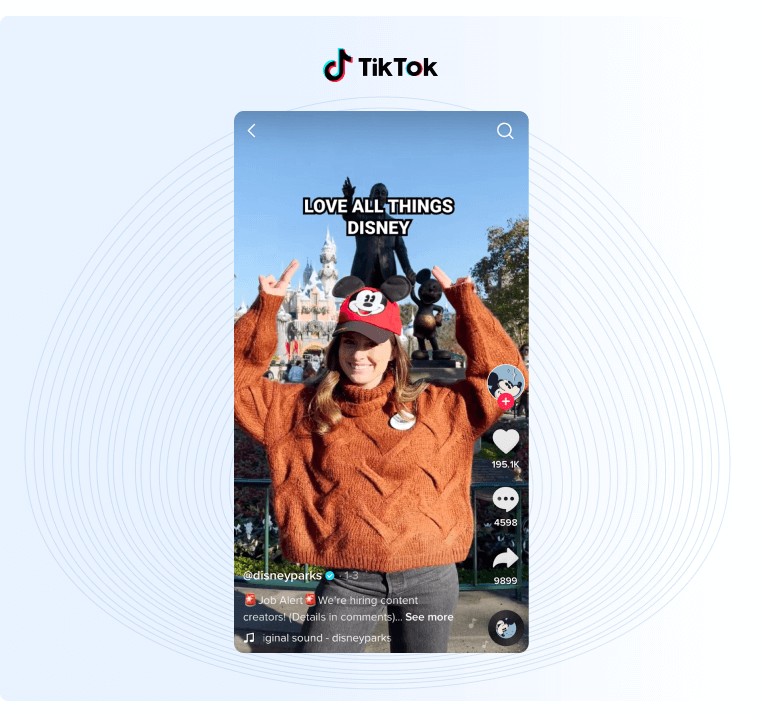
Example of Disney Parks recruiting on TikTok
2. Create Content That Showcases Your Company’s Culture
After landing on your company page, the next thing a potential applicant will probably do is scroll through your content. So rather than cluttering the page with job descriptions, create content that highlights achievements, culture perks, and other aspects that make people want to work there.
We've found that this approach is far more effective than cluttering the company page with endless job posts because it shifts your brand image from desperate to hire to an exciting company that anyone would be lucky to join.
To give you some inspiration, check out Intercom's company page. They create various culture posts like the one below to make employees want to work there:
When Intercom was ready to hire, rather than creating boring job posts, they created excellent video content that showcases their employees and communicates how amazing it is to work for the brand.
However, you can also use the "Jobs" tab (on LinkedIn) to advertise specific jobs.
We'll also discuss how you can leverage employees to share specific job openings for you. This way, your company page isn't littered with job posts, and you can instead focus on creating inspirational content that makes candidates want to work with you.
3. Create Employee Engagement Assignments
We already discussed the chief benefits of leveraging your employees' social networks to promote job posts, including:
- Job posts published on employee accounts tend to attract higher quality candidates as your A-players likely interact with other A-players.
- You can exponentially scale your job post's impressions because the total sum of your employees' networks is likely much larger than the company page's reach.
- Social media algorithms tend to give more organic reach to posts published on personal social media accounts rather than company accounts.
The main issue with leveraging employee advocacy to promote job posts is that it can be tricky to create a scalable workflow.
Most managers try one of two workflows when first launching an employee advocacy campaign:
-
Sending mass Slack messages/emails to a group of people to promote available jobs. The problem with this strategy is that it often becomes noisy. So even if a few people take action initially, the engagement usually fizzles out.
-
Sending specific Slack messages/emails to relevant people with specific job share requests. By personally sending specific requests to specific people, this strategy tends to generate better response rates, though it's also not very scalable. Before long, you'll find yourself spending hours creating and sending these messages.
To solve problems like this, we created GaggleAMP, which makes it easy for you to send personal engagement requests to employees at scale.
Here's a brief overview of how it works:
Step 1: Create an Engagement Activity
GaggleAMP has a variety of engagement cards with predefined activities (like, follow, comment, etc.) for all of the major social media platforms.
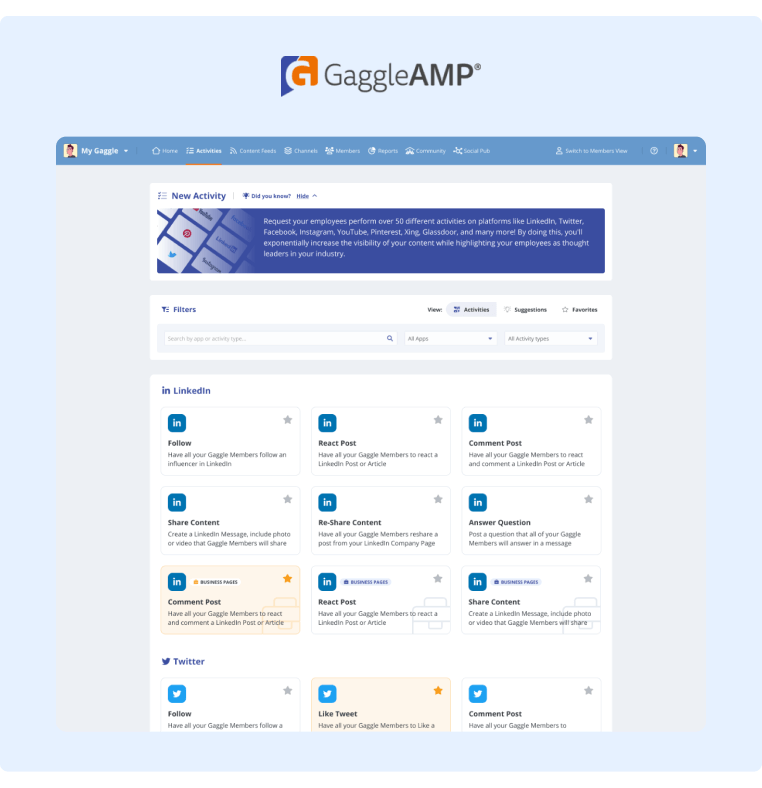
You can customize each engagement card with specific instructions, a start and end date, and a link.
To give you an example of this in action, you can use the LinkedIn Share Activity and request that employees promote a new customer success position.
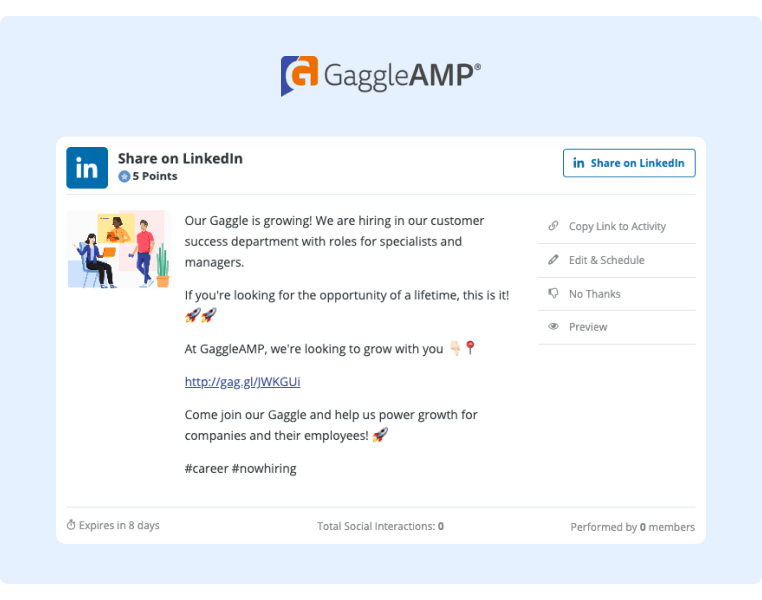
Step 2: Assign Activities to Specific Employees (or a Group of Employees)
Once you’ve created the engagement activity, you can assign it to a specific employee or a group of employees. For example, if you have a new marketing position open, you can assign it to everyone in the marketing department.
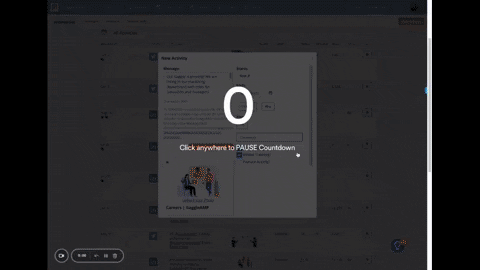
As you can see, this process makes it easy to assign specific engagement activities to specific employees (or groups) at scale.
Step 3: Employees Complete The Activities in Minutes
We realized that the key to a sustainable employee engagement strategy is making it super easy for employees to engage. For this reason, we designed GaggleAMP to remove as much friction as possible for employees to engage.
The first point of friction Gaggle removes for employees is selecting a post to engage with or (if you’re assigning them to create their own post to promote a brand initiative) thinking of something to say. While this may seem like a small task, it's often a key point of friction that ultimately leads to a significant decline in engagement.
Therefore, each employee has their own personal Gaggle with specific engagement activities assigned by the manager.
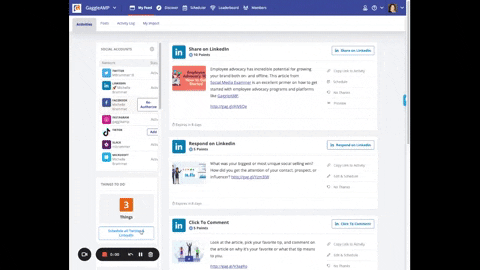
In addition, GaggleAMP allows employees to schedule posts to publish at a future date. This way, they can complete all their engagement assignments in one sitting, yet their engagement activities still go live throughout the week.
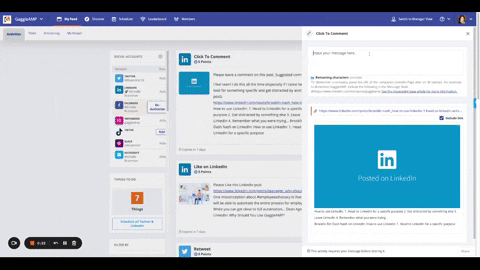
To see for yourself how GaggleAMP can improve your recruitment process by making it easy to get employees to share relevant job opportunities, schedule a demo today.
4. Help Employees Create Their Own Content Strategies
Your employees' combined professional networks is one of your most powerful recruiting channels, so helping them grow their social audience is highly beneficial for your talent acquisition strategy.
Therefore, teach your employees (especially key executives) how to create content that helps them build an audience, establish themselves as thought leaders, and ultimately attract top talent.
While we have a separate guide on building a personal brand on LinkedIn, here are a few tips to help your employees implement an effective content strategy.
Tip #1: Create Content That’s Social
Much of the content on LinkedIn offers unsolicited advice, though people hang out on social media because they want to hear about personal experiences, thoughts, and opinions. So instead of telling the audience what to do, create content that provides interesting insights through personal experiences.
Here's an excellent example of a piece of content that teaches a valuable lesson through a personal experience.
In the post above, if the person had simply said, "It's important to have an SEO guide web design changes," it wouldn't have been nearly as impactful as this story. Adding the personal experience makes it more interesting and adds credibility to the lesson because the data speaks for itself.
Another tip is to add a visual whenever possible because they help capture attention and pull people into your post. This could be a graphic, a screenshot (like the one above), or a video.
Tip #2: Connect With Other Thought Leaders
In addition to creating content, it's also useful to invest in building real relationships with other thought leaders. This can open doors to future collaborations, and they might also share your content with their audience.
So how do you build relationships with thought leaders on social media?
Start by leaving thoughtful comments on the influencer's posts and support their new content whenever they publish. Then, send them a message and let them know that you love their content.
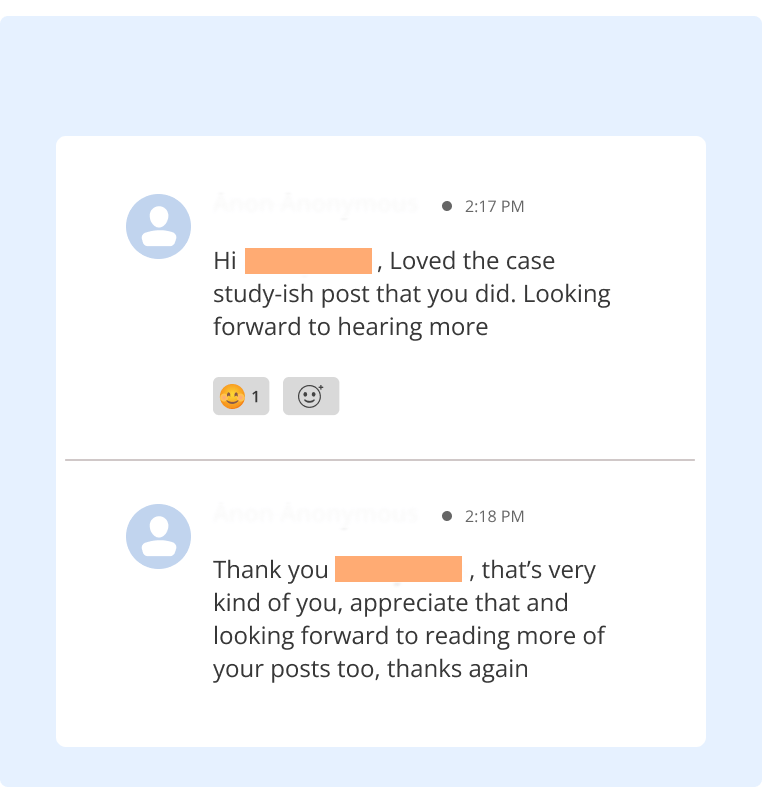
Obviously, this isn't a scalable strategy that you can use on hundreds of influencers at once, so select just a handful of people (10-20). Ideally, the micro-influences you select have a sizable audience, yet not so large that they won't notice you actively engaging with their content.
Over time, you'll be able to build a genuine relationship with these people, and it's quite likely that, in time, they'll share your content with their audience (for free!).
Tip #3: Join and Support Relevant Groups
Another great way to build your audience is to join groups and then, rather than just posting content, help others with their questions.
People remember when others help them and are highly likely to follow or connect with you outside of the group if your advice is helpful.
Tip #4: Remain Consistent and Don’t Give Up
Finally, consistency is key to building a strong social media presence for a few reasons.
Not every post will take off, so it's important to create a high volume of posts to score a few home run posts.
In addition, social media posts are usually only relevant for a few hours, so if you aren't posting consistently, people will quickly forget who you are and what you do.
To improve posting consistency, consider using a post scheduler so that you only need to devote one day per week to creating social content, yet the posts still publish throughout the week.
By implementing this content strategy, your current employees will soon build their own audience and ultimately give your brand a much more powerful microphone for promoting new job opportunities.
An added benefit of having a company full of thought leaders is that it will organically attract other top talents, as A players love working with other A players.
Pro Tip: If you're struggling to get critical employees (such as executives) to produce content for their own social profiles consistently, you can help them out by using GaggleAMP's Question card. This way, you can give them specific content prompts to make the ideation process easier. Here are just a few example prompts you can assign:
- What is one failure story you think your peers would benefit from knowing?
- What is something interesting you learned this week that your peers could benefit from knowing?
- What is a case study with a lesson that you can share?
- What is an interesting nugget you learned from a recent conversation?
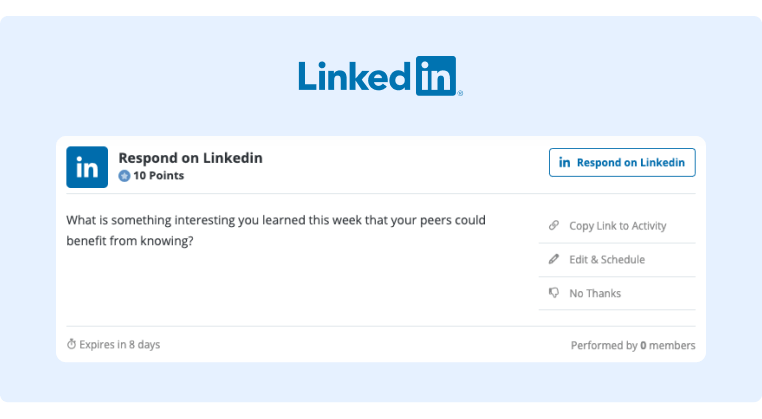
From there, the executives can schedule the post to go live at a future date.
5. Optimize Posts to Boost Visibility and Engagement
Now that you have a great process in place, here are a few tips to maximize each campaign's reach and conversions.
First, use relevant hashtags. While most people use traditional hashtags like #hiring, #jobs2022, and #recruiting, get more specific by using industry-specific hashtags like:
- #marketingjobs
- #seojobs
- #copywritingjobs
By using more specific hashtags, you'll attract higher-quality candidates who are actively searching for a job.
In addition, when you ask employees to publish a post about open job positions, give them specific instructions on what to include in the post.
Otherwise, most employees just post something generic like:
"We're hiring a marketing manager. Come join our amazing team!"
So instead, ask employees to mention at least one of the following:
- The type of career advancement opportunities the company provides
- Something that they love about the company culture
- Their experience working at the company
For example, notice that this is a much more compelling job description that would appeal to A players:
"We're expanding our content marketing efforts and looking to add one more talented content marketer to our team. This is an amazing opportunity for an ambitious marketer who wants to further their career as (brand) encourages experimentation, supports mentorship, and takes its team members' ideas seriously.
I can attest to this as I joined about five years ago as an entry-level copywriter, and today, I'm the senior content marketing manager.
As a content marketer on our team, you'll be in charge of all of the blog content and work with the team to create webinars, white papers, and other critical pieces of content to drive the brand forward."
As you run recruiting campaigns, be sure to track the analytics so that you can find patterns in the most successful campaigns and iterate on those themes.
6. Actively Reach Out To Candidates
While all of the strategies up until now have focused on attracting candidates, you can also use social media channels to actively recruit potential applicants.
To find quality candidates, here are a few places to look:
- Your competitors (though be careful to feel out the waters before outright offering a position)
- Parallel industries
- Other companies you’ve hired current employees from
- Employee connections (you can even ask for employee referrals)
If you’re using LinkedIn, you can also use their basic People search feature to filter candidate profiles, though it also offers a premium tool, LinkedIn Recruiters, which offers more advanced search features.
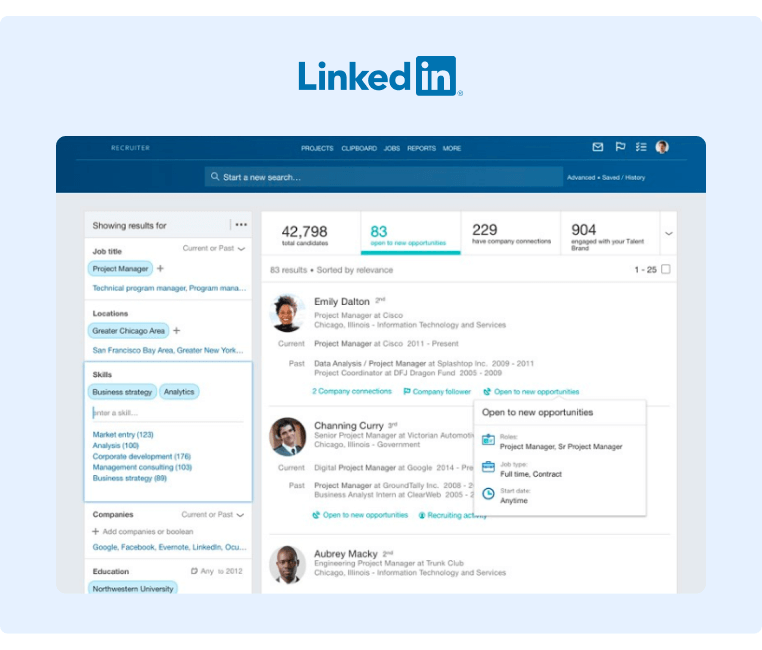
Once you've created a list of potential candidates, here's a template you can use to reach out to them:
"I'm impressed with what you've done for (current company) and was wondering if you'd be interested in taking your career up another level? We're looking for a (job title), and with your years of experience in (field), I thought you might be a good fit. Would you be open to discussing this opportunity more?"
This message is open-ended and adds a little bit of flattery, which tends to increase response rates.
Excellent Social Media Recruiting Examples
If you’re looking for some more inspiration to help you improve your social media recruiting strategy, here are a few examples of excellent posts that generated plenty of visibility and reach.
Example #1: Amazon
This is a great example of how employees can promote jobs for you. It begins as a story discussing how Amazon helped this employee improve his career and reach a new turning point in his career. The post then ends with a CTA to apply for other jobs at the company.
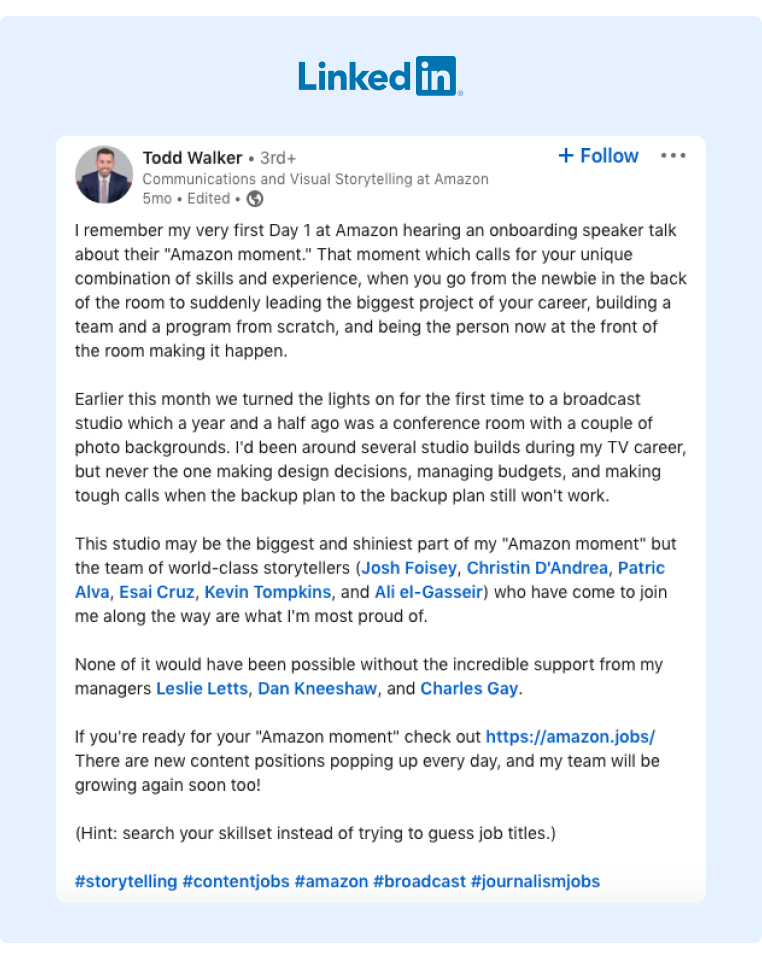
The post performed phenomenally with nearly 50 comments and almost 250 engagements.
Example #2: Topl
This post is another clever example of an employee weaving a recruiting pitch into a personal announcement post.
By starting the post as a personal announcement, people are much more likely to engage, which helps boost the post's visibility and get in front of more candidates.
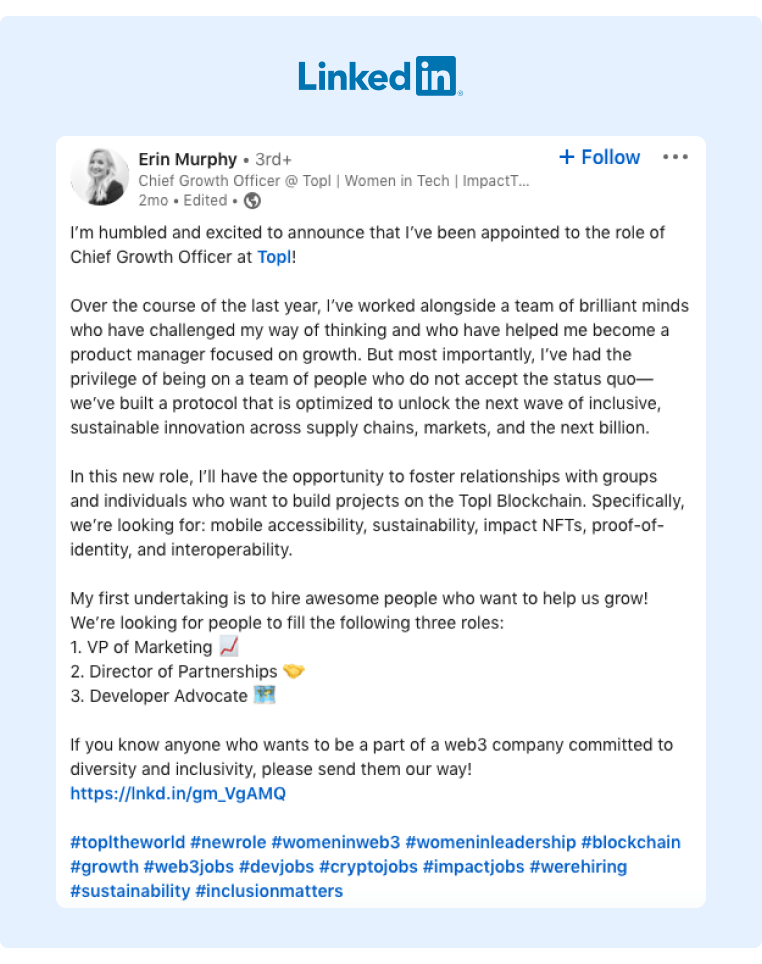 So next time you hire a C-suite executive, consider mentioning how they can leverage the announcement post to promote other relevant jobs.
So next time you hire a C-suite executive, consider mentioning how they can leverage the announcement post to promote other relevant jobs.
Example #3: Monte Carlo Data
Here's another great example of how employees can promote jobs for the company by discussing their experience working there.
From a tactical standpoint, this post is well-crafted as it opens with a personal update and then dives into more specific details of why the company is a great place to work.
It ends with a CTA, three relevant hashtags, and adds the link in the comments (rather than the post itself).
Example #4: Felvin
This post is a fairly traditional hiring post explaining what the company is looking for, though the commenters are the key differentiating factor. Many commenters state aspects they admire about this founder and why it's a great opportunity to work with him. This engagement also gave the post more visibility.
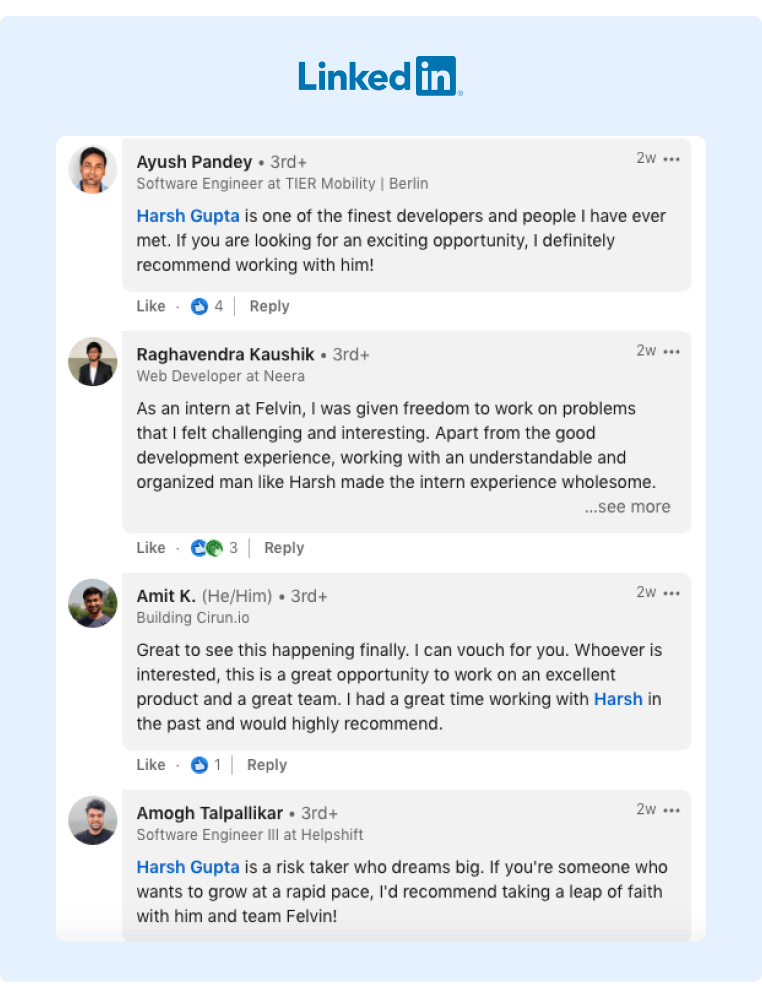
Therefore, ask other employees to engage with hiring posts published by fellow co-workers and mention specific reasons why it’s a great opportunity.
Example #5: Coinbase
This post published by a Coinbase employee describes the three best things about working at Coinbase. While he mentions that they are hiring for new positions at the end of the post, the purpose of the post is more to get people excited about the company.
It worked out well, generating 800 engagements and 60 comments.
Start Leveraging Your Employees’ Networks to Recruit Top Talent
We strongly believe that your employees are the most effective recruiters because they have a much stronger relationship with their network than your brand has with cold prospects.
So rather than just posting traditional recruiting posts on social media, think about how you can reach potential employees through your existing employees.
If you’re struggling to get your employees to promote key job opportunities on social media, consider using GaggleAMP. It’s an all-in-one platform that makes it super easy to:
-
Assign key job opportunities to employees to promote
-
Enable employees to access a handful of relevant engagement assignments, complete them inside the platform, and schedule them to publish at a future date
-
Track key metrics to effectively measure the ROI of your campaigns and track employee engagement
To level up your social media recruiting efforts, schedule a demo of GaggleAMP today, or try it out today risk free!

